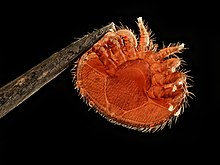| Varroa mite | |
|---|---|

| |

| |
| Varroa destructor adult female in dorsal (top) and ventral (lower) views | |
| Scientific classification | |
| Domain: | Eukaryota |
| Kingdom: | Animalia |
| Phylum: | Arthropoda |
| Subphylum: | Chelicerata |
| Class: | Arachnida |
| Order: | Mesostigmata |
| Family: | Varroidae |
| Genus: | Varroa |
| Species: | V. destructor
|
| Binomial name | |
| Varroa destructor Anderson & Trueman, 2000[1]
| |
Varroa destructor, the Varroa mite, is an external parasitic mite that attacks and feeds on honey bees and is one of the most damaging honey bee pests in the world.[2][3] A significant mite infestation leads to the death of a honey bee colony, usually in the late autumn through early spring. Without management for Varroa mite, honey bee colonies typically collapse within 2 to 3 years in temperate climates.[4] These mites can infest Apis mellifera, the western honey bee, and Apis cerana, the Asian honey bee. Due to very similar physical characteristics, this species was thought to be the closely related Varroa jacobsoni prior to 2000, but they were found to be two separate species after DNA analysis.
Parasitism of bees by mites in the genus Varroa is called varroosis. The Varroa mite can reproduce only in a honey bee colony. It attaches to the body of the bee and weakens the bee.[5] The species is a vector for at least five debilitating bee viruses,[5] including RNA viruses such as the deformed wing virus (DWV). The Varroa mite is the parasite with possibly the most pronounced economic impact on the beekeeping industry and is one of multiple stress factors contributing to the higher levels of bee losses around the world.[6] Varroa mite has also been implicated as one of the multiple causes of colony collapse disorder.
Management of this pest focuses on reducing mite numbers through monitoring to avoid significant hive losses or death. 3% of bees infested in a hive is considered an economic threshold where damage is high enough to warrant additional management. Miticides are available, though some are difficult to time correctly while avoiding harm to the hive, and resistance has occurred for others. Screened bottom boards on hives can be used for both monitoring and mite removal, and drone comb that mites prefer can be used as a trap to remove mites from the hive. Honey bee lines in breeding programs also show partial resistance to Varroa mite through increased hygienic behavior that is being incorporated as an additional management strategy.
- ^ Cite error: The named reference
Anderson and Trueman 2000was invoked but never defined (see the help page). - ^ Zakar, E.; Jávor, A.; Kusza, Sz. (August 2014). "Genetic bases of tolerance to Varroa destructor in honey bees (Apis mellifera L.)". Insectes Sociaux. 61 (3): 207–215. doi:10.1007/s00040-014-0347-5. S2CID 253641352.
- ^ Onstad, David, ed. (2008). Insect resistance management: biology, economics and prediction (1. ed.). Amsterdam: Elsevier/Acad. Press. p. 157. ISBN 978-0-12-373858-5.
- ^ Rosenkranz, Peter; Aumeier, Pia; Ziegelmann, Bettina (January 2010). "Biology and control of Varroa destructor". Journal of Invertebrate Pathology. 103: S96–S119. Bibcode:2010JInvP.103S..96R. doi:10.1016/j.jip.2009.07.016. PMID 19909970.
- ^ a b Ramsey, Samuel D.; Ochoa, Ronald; Bauchan, Gary; Gulbronson, Connor; Mowery, Joseph D.; Cohen, Allen; Lim, David; Joklik, Judith; Cicero, Joseph M.; Ellis, James D.; Hawthorne, David; vanEngelsdorp, Dennis (29 January 2019). "Varroa destructor feeds primarily on honey bee fat body tissue and not hemolymph". Proceedings of the National Academy of Sciences. 116 (5): 1792–1801. Bibcode:2019PNAS..116.1792R. doi:10.1073/pnas.1818371116. PMC 6358713. PMID 30647116.
- ^ Goulson, D.; Nicholls, E.; Botias, C.; Rotheray, E. L. (26 February 2015). "Bee declines driven by combined stress from parasites, pesticides, and lack of flowers" (PDF). Science. 347 (6229): 1255957. doi:10.1126/science.1255957. PMID 25721506. S2CID 206558985.